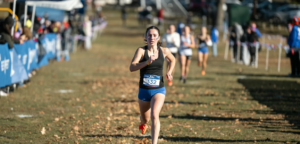As we approach the championship season, I would like to offer a few lessons I’ve gleaned as a new coach.
Most importantly, the XC season is a long one. It would be a mistake to place a heavy emphasis on any one workout or training week. Athletes who train consistently and avoid injury will gradually progress over the course of the season and pushing too hard at any one point in the season could result in less than ideal outcomes later on. Helping runners to see the bigger picture, that ultimately the first meet that matters is the state meet, and encouraging an ethic of work toward that end has helped my runners shrug off mediocre races and workouts.
 Another important lesson is that runners respond very differently to workouts. Generally speaking, the goal of a workout is to stress one or multiple energy systems and then allow for the adaptation that follows through rest or easy running. There is no one-size-fits-all model and while, as a coach, you want to hold everyone to a high standard of training, some athletes need modified workouts, easier recovery days and/or days completely off. And, some kids are tough and will push through fatigue or injury when they shouldn’t. Mentally tough kids may actually be more challenging to coach well because it can prove more difficult to tell how they’re feeling and direct them effectively. Therefore, creating a team culture where athletes are encouraged to communicate these things with their coach is essential.
Another important lesson is that runners respond very differently to workouts. Generally speaking, the goal of a workout is to stress one or multiple energy systems and then allow for the adaptation that follows through rest or easy running. There is no one-size-fits-all model and while, as a coach, you want to hold everyone to a high standard of training, some athletes need modified workouts, easier recovery days and/or days completely off. And, some kids are tough and will push through fatigue or injury when they shouldn’t. Mentally tough kids may actually be more challenging to coach well because it can prove more difficult to tell how they’re feeling and direct them effectively. Therefore, creating a team culture where athletes are encouraged to communicate these things with their coach is essential.
Concerning race preparation, I have been a believer in having a very reliable,  consistent series of tasks to complete during the hour leading up to a race. However, at the Manchester Invitational, our team got started on their warm-up 20 minutes behind schedule, leading some of the team to panic as the race drew near. Even more recently, at Kennett we got off the bus and had to immediately start our warm-up run. These events led me to realize that we need to practice how to handle unexpected circumstances. Learning how to be flexible, focusing on the things within your control, can teach you how to respond as well as possible, whether it’s during a warm-up or the race itself.
consistent series of tasks to complete during the hour leading up to a race. However, at the Manchester Invitational, our team got started on their warm-up 20 minutes behind schedule, leading some of the team to panic as the race drew near. Even more recently, at Kennett we got off the bus and had to immediately start our warm-up run. These events led me to realize that we need to practice how to handle unexpected circumstances. Learning how to be flexible, focusing on the things within your control, can teach you how to respond as well as possible, whether it’s during a warm-up or the race itself.
Also, footwear matters a lot. Expressing the need to acquire and maintain fresh and correctly fit shoes is essential to avoiding injuries and continuing runners’ progress. We held a spike night at Runner’s Alley, which got the team off to a great start as the well-trained staff knew how to fit my team appropriately. My background in gait analysis also helped me identify kids whose shoes had broken down or were simply not the correct fit. Encouraging those kids to make footwear changes benefited their training and racing.
Finally, tempo running works wonders in distance running. Until this week, the shortest interval workout our team had run was tempo reps at 1000m with short rest. Examples of workouts include: 20-30-minute tempo runs, 5 x 1 mile on 2 minutes rest, 4 x 2000m on 2:30 rest, 3 x 2 miles on 4 minutes rest, etc. We have spent very little time running VO2 max level efforts (very hard, fast running), as cross country running is primarily an aerobic event. As we approach the championship season, we will incorporate shorter, faster intervals with longer recoveries to sharpen and prepare for fast starts, hills, and strong finishes. The workouts we have done thus far, contrast quite a bit with how training used to be done at Oyster River, and it took real buy-in from the team to trust that the new system would pay off.
x 2000m on 2:30 rest, 3 x 2 miles on 4 minutes rest, etc. We have spent very little time running VO2 max level efforts (very hard, fast running), as cross country running is primarily an aerobic event. As we approach the championship season, we will incorporate shorter, faster intervals with longer recoveries to sharpen and prepare for fast starts, hills, and strong finishes. The workouts we have done thus far, contrast quite a bit with how training used to be done at Oyster River, and it took real buy-in from the team to trust that the new system would pay off.
-Scott McGrath, Oyster River Boys XC Coach












One Response
I have thoroughly enjoyed reading your past few articles. Thanks for your contributions